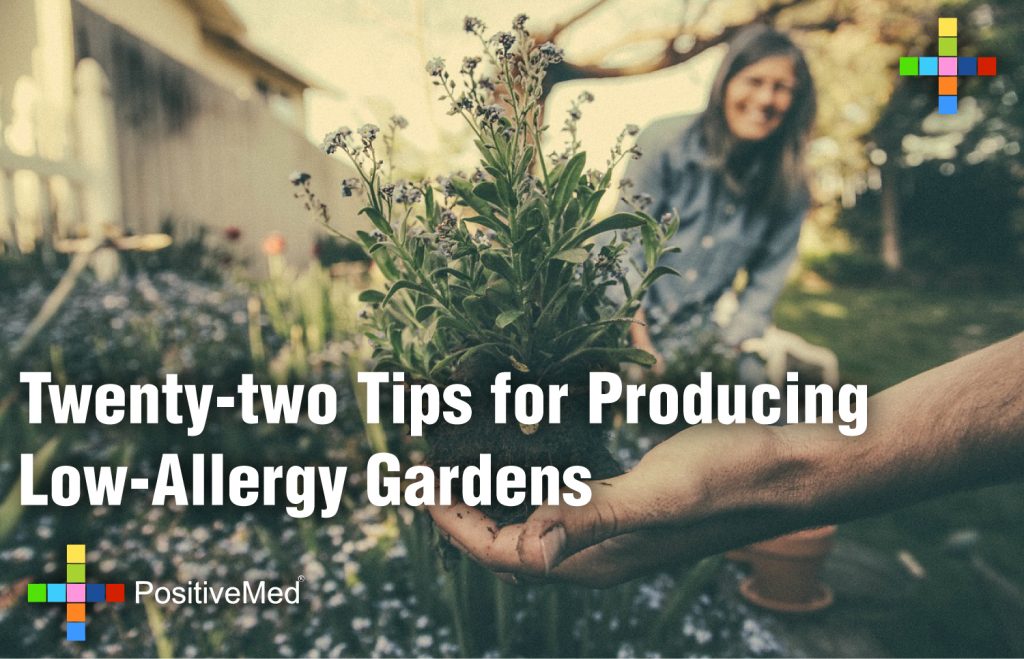© Thomas Leo Ogren
What we plant in our own yards often has a direct effect on our own health and the health of those near us. A pollen-producing male tree in our own yard will easily expose us to ten times more pollen than would a similar tree growing just down the block. This can be compared to second-hand smoke. Yes, it is possible to inhale some smoke from a person who is smoking a block or two away from you, but it is hardly the same as someone smoking right next to you. It is the same with plants. If your own yard is full of allergenic plants, then you will be exposed most.

The greater your exposure, the greater your chances are of having allergies and (or) asthma. Here are some tips to avoid allergies and asthma.
Related Link: Bottle Tower Garden
1. Don’t plant any male trees or shrubs. These are often sold as “seedless” or “fruitless” varieties but they’re males and they all produce large amounts of allergenic pollen.
2. Do plant female trees and shrubs. Even though these may be messier than males, they produce no pollen, and they actually trap and remove pollen from the air. There is also some very good all-female sod to use for pollen-free lawns. As an added bonus, these female lawns stay low and require less frequent mowing.
3. Plant disease-resistant varieties. mildew, rust, black spot and other plant diseases all reproduce by spores and these spores cause allergies. Disease resistant plants won’t get infected as much and the air around them will be healthier.
4. Use only trees and shrubs well adapted for your own climate zone. Plants grown in the wrong zone will often fail to thrive. Because they are not healthy, they will be magnets for insects. Insect residue, “honeydew,” is a prime host for molds and molds produce allergenic mold spores. Often native plants will be the healthiest choices.
5. Be careful with the use of all insecticides, fungicides, and herbicides. Accidental exposure to all of these chemical pesticides has been shown to cause breakdowns in the immune system. Sometimes one single heavy exposure to a pesticide will result in sudden hypersensitivity to pollen, spores, and to other allergens. This is as true for pets as it is for their owners. Go organic as much as possible. Make and use compost!
6. Diversity is good. Don’t plant too much of the same thing in your landscapes. Use a wide selection of plants. Lack of diversity often causes over-exposure. Use lots of variety in your gardens.
7. Wild birds are a big plus because they eat so many insects. Plant fruiting trees and shrubs to encourage more birds. Suet also attracts many insect-eating birds. Insect dander causes allergies and birds consume an incredible amount of aphids, whiteflies, scale, and other invertebrate pests.
8. Use pollen-free selections whenever possible. There are many hybrids with highly doubled flowers and in many cases, these flowers lack any male, pollen parts. Formal double chrysanthemums, for example, usually have no pollen. Another example would be almost all of the erect tuberous begonias. These have complete female flowers, but their male flowers have nothing but petals, making them pollen-free.
9. If you simply must have some high-allergy potential plants in your yard, just because you love them, then watch where you plant them. Don’t use any high-allergy plants near bedroom windows or next to patios, well-used walkways, or by the front or back doors. Place the highest allergy plants as far away from the house as possible and downwind of the house too. Remember: the closer you are to the high-allergy tree or shrub, the greater is your exposure.
10. Know the exact cultivar name of a tree or shrub before you buy it. Don’t buy any that are not clearly tagged with the correct cultivar (variety) name and the Latin, scientific name. Compare the exact name of the plant with its OPALS/TM allergy ranking. With this scale, 1 is the least allergenic, and 10 is the most allergenic. Try to achieve a landscape that averages at OPALS #5, or below.
11. If you have a tree or hedge that has high allergy potential and don’t want to remove it, consider keeping it heavily sheared so that it will flower less. Boxwood, for example, has allergenic flowers but if pruned hard each year, it will rarely bloom.
12. Get involved with your own city’s tree and parks departments, and encourage them to stop planting any more wind-pollinated male trees. There are thousands of fine choices of street trees that do not cause any allergies and we should be using these instead. Working together we can make a healthy difference, and we’ll all breathe better for our efforts.
13. Some localities have enacted pollen-control ordinances. These prohibit the sale and planting of the most highly allergenic trees and shrubs. These ordinances can help save lives and lead to more responsible and more considerate landscaping. Why not get involved and have such a rule of law in your own community?
14. There are a great many very useful female cultivars of Red Maple (Acer rubrum), such as ‘October Glory’ and ‘Red Sunset.’ These trees have exceptional fall color and are pollen-free.
15. Female Junipers (Juniperus spp.) are pollen-free and have beautiful blue-green berries. Numerous female cultivars are sold, such as ‘Blue Point,’ ‘Icee Blue,’ and ‘Hollywood Juniper.’
16. Some trees such as the sycamores and London Plane trees (both Platanus species) produce fuzz on their leaves and stems. This fuzz can become airborne and causes a skin rash, itching, and irritation of the eyes, throat, and lungs. If you must use them, avoid planting them too close to your house.
17. Pets can and do get allergies too. Often the exact same plants that cause us allergy, will also affect our pets. Dogs and cats, in particular, may be allergic to pollen. Animals can’t tell us what bothers them. They need us to look out for them.
18. Children are especially susceptible to allergies and asthma. It is crucial that the shade trees in elementary schools be selected to be as pollen-free as possible. Asthma is now the number one most common chronic childhood disease.
19. Older people and especially those in hospitals or retirement homes are also at increased risk from excessive pollen. Shrubs near windows need to be allergy-free. Pollen is tiny and can easily pass through even the tightest window screens.
20. Trees and shrubs next to any bedroom windows will have a large effect on the health of the people inside these bedrooms. Never plant any high pollen producers close to bedrooms windows.
21. Poisonous plants such as Podocarpus or Yews, if they are male, will shed millions of grains of airborne pollen. Pollen from the males of these two species is both allergenic and poisonous.
22. Watch out for strong smelling plants as many of them can trigger allergies. Tiny droplets of airborne fragrance oils from landscape plants such as jasmine and lantana will frequently cause allergies for anyone who is perfume-sensitive.
*Note, with dioecious plants (separate-sexed) only males cause pollen-allergy, and females because they are pollen free, do not. Some examples of dioecious plants are: red maple, silver maple, box elder, holly, willow, aspen, cottonwood, poplar, fringe tree, pepper tree, carob tree, Osage orange, mulberry, cedar, juniper, Podocarpus, yews, ash, date palms, and even such common garden plants as asparagus.
Remember, what you plant can also affect your immediate neighbors. Practice considerate planting. Plant allergy-free.
See: https://en.wikipedia.org/wiki/OPALS_(Ogren_Plant_Allergy_Scale)
Thomas Ogren is the author of Allergy-Free Gardening, from Ten Speed Press. More than 3,000 plants are individually allergy-ranked (OPALSTM) in this book. Tom does consulting work on landscape plants and allergies for the USDA, for county asthma coalitions, arborist and landscape design associations, and the Canadian and American Lung Associations. He has appeared on National Public Radio, on HGTV, CBS Evening News, and The Discovery Channel. He has an MS in Agriculture/Horticulture and writes for such diverse publications as New Scientist, Earth Island Journal, Landscape Architecture, American Rose, Pacific Coast Nurseryman, Alternative Medicine, Women’s Day, and Wild Ones Journal. Tom can be reached through his website at www.allergyfree-gardening.com or at www.safegardening.org







